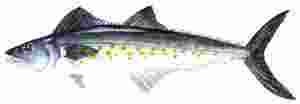Spanish Mackerel are pretty abundant, fun to catch, and very good to eat. Each year they migrate up and down the east coast of the United States and in along the Gulf Coast, usually as soon as the water temperature reaches 65 degrees. In addition, you don’t even have to go out very far to catch them!
Spanish Mackerel resemble King Mackerel. However, there is one big distinction between the two – King Mackerel have a lateral line that drops along their sides. Spanish Mackerel just have a straight line all the way across. Spanish average around 20 inches long and typically weigh-in around one to five pounds.
Go to your local tackle store and get a few small contraptions called Clark Spoons and a few Gotcha plugs. You can get these in any size and any color – you pick. If they won’t hit one, they will hit the other. Make sure you pick up a handful because Spanish are notorious for biting lines off, and leader isn’t a good idea because of their sharp eyesight.
Ok. Now that you have your tackle, know that Spanish Mackerel typically run early in the mornings and late in the day. Go to a sea buoy around an inlet, troll along the beaches, or go to the pier. It doesn’t matter if you are on a boat or on the pier, you can catch Spanish Mackerel with hardly any effort most times!
Take a spoon and tie it directly on your line. I typically use just a fisherman’s knot. Set the drag to a few pounds – light. Put the boat in gear and start to troll the spoons. Kick up a small wake – that’s usually a good way to land Spanish. You can troll one or even four spoons at one time – I don’t troll anymore than two at a time though. I keep the two at different yards behind as well.
Look around for bird’s diving in the water or fish jumping and splashing around. That’s where you want to troll around. Do not troll straight through the schools. Go around them in the direction they are moving. If you troll straight through them the fish will go down and you won’t catch one. Also, if there are other fishermen around and you put the school down, you will be faced with screams, foul gestures, and bad name-calling.
You can also catch Spanish Mackerel on high tides and tide lines. A tide line is the line made by the dirty water coming out of the inlet. It is usually very obvious. Troll your spoons along the clean side of the tide line.
Gotcha plugs are another good tackle of choice. These are used as jigs either from fishing on boats or piers. Tie the Gotchas directly onto your fishing line. Again, I just use a simple fisherman’s knot. Cast the line out into the water as a blind cast or into a school of Spanish. Jig the Gotcha along, reeling it in as you do. Try various speeds. The jumpy action of the Gotcha will fool the Spanish into thinking it is a small baitfish jumping around.
Fishing for Spanish Mackerel is easy and fun to do for people of all ages and skill levels on light tackle. Check into your local regulations on Spanish limits and citation sizes. At the end of the day, clean them, fillet them out, and throw them onto the grill for a tasty dinner!

